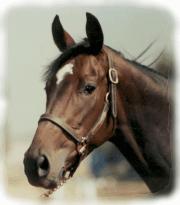A Horse, of Course with Don Blazer |
If you enjoy learning about horses, then you'll love our online courses. Each month you'll find a new column on our web site. We hope you'll enjoy it, and maybe e-mail us with questions or suggestions for other columns. A Horse, Of Course is a monthly column syndicated by Success Is Easy. If you like the column, call your local newspaper, or local horse publication and ask them to subscribe by contacting Success Is Easy. |
Dealing With Inflammation Don Blazer copyright©2013 |

There are all kinds of conceptual
contradictions in the horse world, and inflammation is one of them. Inflammation can be both good and bad at the same time. And to relieve the bad effects of inflammation horsemen often deliberately create more in the hope that an injury will be healed in a shorter length of time. Inflammation is a reaction of the body to injury, and is commonly characterized by heat, redness, swelling, pain and disturbed function. Since inflammation is a natural response by injured tissue, inflammation is present every time the horse sprains, strains, bumps, twists, cuts or punctures some part of his body. It also occurs when the horse is attacked internally by viruses, bacteria, chemicals or parasites. The immediate reaction to an injury is usually swelling of the surface of the injured area; redness is noted. The body sends an increased supply of blood to the injured area, much as we would send extra fire-fighting units to a major blaze. The increased blood supply provides more white blood cells which are responsible for removing contamination and debris caused by injury. The purpose of natural inflammation is to kill infectious agents, prevent the spread of disease, clean up the damage and heal the injury. But sometimes horsemen want to hasten the natural healing process. This is done in two ways. The first is to clean the injury and make it as free of contamination as possible. This creates the most advantages climate for the body to heal itself, and is a very good idea. In an effort to hasten the healing, horsemen sometimes create additional inflammation by using an agent which causes even more damage, thus creating an even greater supply of blood to the area. An example is blistering a horse if the animal has shin bucked. When a horse shin bucks, the tissue along the front of the cannon bone is damaged and natural inflammation is immediate. The application of a blister (through the use of a caustic agent) encourages additional swelling due to increased blood supply; the increased blood supply resulting in quicker healing. Internal blisters within joints are often performed by veterinarians. Whether any blisters or “firing” are beneficial is a matter of opinion. It’s my opinion that blistering or firing is ineffective, unnecessary and without any reasonable justification. Unfortunately it is impossible to prove the benefits or lack thereof of an increased inflammation. There are alternative ways to treat injury…such as “cooling”. But no matter how it is treated, when there is an injury there is inflammation. Given enough time, (a tincture of time is often the best medicine) the natural healing process usually repairs or replaces the damaged tissues and restores good health to the area. Ordinarily horsemen don’t say “inflammation”, but instead indicated what is inflamed by adding “itis” to the word for the affected area of the horse. For example, an inflamed tendon is “tendonitis”, whereas an inflammation on the horse’s skin would be “dermatitis”. When a horse is injured, inflammation is beneficial because it is part of the natural healing process. At the same time it is bad because it creates swelling, congestion, pain and heat. And inflammation is even more contradictory because horsemen often make it worse in an attempt to make it better. |